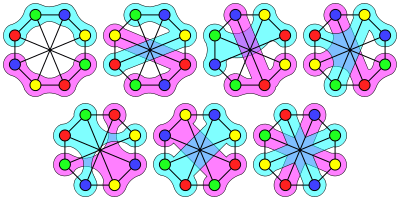Strong coloring
In graph theory, a strong coloring, with respect to a partition of the vertices into (disjoint) subsets of equal sizes, is a (proper) vertex coloring in which every color appears exactly once in every part. A graph is strongly k-colorable if, for each partition of the vertices into sets of size k, it admits a strong coloring. When the order of the graph G is not divisible by k, we add isolated vertices to G just enough to make the order of the new graph G′ divisible by k. In that case, a strong coloring of G′ minus the previously added isolated vertices is considered a strong coloring of G. [1]

The strong chromatic number sχ(G) of a graph G is the least k such that G is strongly k-colorable. A graph is strongly k-chromatic if it has strong chromatic number k.
Some properties of sχ(G):
Here Δ(G) is the maximum degree.
Strong chromatic number was independently introduced by Alon (1988)[4][5] and Fellows (1990).[6]
Related problems
Given a graph and a partition of the vertices, an independent tranversal is a set U of non-adjacent vertices such that each part contains exactly one vertex of U. A strong coloring is equivalent to a partition of the vertices into disjoint independent-transversals (each independent-transversal is a single "color"). This is in contrast to graph coloring, which is a partition of the vertices of a graph into a given number of independent sets, without the requirement that these independent sets be transversals.
To illustrate the difference between these concepts, consider a faculty with several departments, where the dean wants to construct a committee of faculty members. But some faculty members are in conflict and will not sit in the same committee. If the "conflict" relations are represented by the edges of a graph, then:
- An independent set is a commitee with no conflict.
- An independent transversal is a committee with no conflict, with exactly one member from each department.
- A graph coloring is a partitioning of the faculty members into committees with no conflict.
- A strong coloring is a partitioning of the faculty members into committees with no conflict and with exactly one member from each department. Thus this problem is sometimes called the happy dean problem.[7]
References
- Jensen, Tommy R. (1995). Graph coloring problems. Toft, Bjarne. New York: Wiley. ISBN 0-471-02865-7. OCLC 30353850.
- Haxell, P. E. (2004-11-01). "On the Strong Chromatic Number". Combinatorics, Probability and Computing. 13 (6): 857–865. doi:10.1017/S0963548304006157. ISSN 0963-5483.
- Haxell, P. E. (2008). "An improved bound for the strong chromatic number". Journal of Graph Theory. 58 (2): 148–158. doi:10.1002/jgt.20300. ISSN 1097-0118.
- Alon, N. (1988-10-01). "The linear arboricity of graphs". Israel Journal of Mathematics. 62 (3): 311–325. doi:10.1007/BF02783300. ISSN 0021-2172.
- Alon, Noga (1992). "The strong chromatic number of a graph". Random Structures & Algorithms. 3 (1): 1–7. doi:10.1002/rsa.3240030102.
- Fellows, Michael R. (1990-05-01). "Transversals of Vertex Partitions in Graphs". SIAM Journal on Discrete Mathematics. 3 (2): 206–215. doi:10.1137/0403018. ISSN 0895-4801.
- Haxell, P. (2011-11-01). "On Forming Committees". The American Mathematical Monthly. 118 (9): 777–788. doi:10.4169/amer.math.monthly.118.09.777. ISSN 0002-9890.